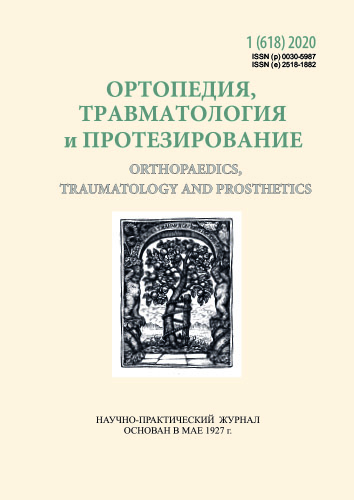Mathematical and computer modeling of a new endoprosthesis with a carbon-carbon composite for interbody fusion of a lumbar spine
DOI:
https://doi.org/10.15674/0030-59872020146-53Keywords:
finite-element models, interbody fusion, implant, vertebral body, stress-strain state, contact pressure, carbon-carbon compositeAbstract
Endoprostheses for interbody fusion should have not only biocompatibility and high strength characteristics, but also good visualization with additional research methods (CT, MRI). One such material is carbon. Aim: using mathematical modeling (the finite element method) to develop a model of the interbody prosthesis from a carbon-carbon composite and evaluate the stress-strain state of the vertebral body-implant system.
Methods: models created in SolidWorks software. 18 design schemes with endoprostheses from a carbon-carbon composite were developed and studied. Bending load was carried out by angular displacements (2°), compressive — by applying a force of 500 N to the upper cubic element. Additional symmetry conditions were also simulated.
Results: a parametric model of the biomechanical system of the lumbar spine was constructed. The smallest equivalent stresses were obtained in the design scheme M17, and the largest — in M13. In the bone elements of the systems, they did not exceed the ultimate strength limits for cortical (160 MPa) and cancellous (18–22 MPa) bones. Contact pressure and displacement are determined for all design schemes.
Conclusions: as a result of the numerical values and distribution fields of the components of the stress-strain state in the elements of the studied systems, it was found that the use of the proposed endoprosthesis made of a carbon-carbon composite, the geometric parameters of which correspond to the design scheme M17, is effective for achieving additional stabilization in the system «vertebral body – implant».
References
- Stradiotti, P., Curti, A., Castellazzi, G., & Zerbi, A. (2009). Metal-related artifacts in instrumented spine. Techniques for reducing artifacts in CT and MRI: State of the art. European Spine Journal, 18(S1), 102-108. https://doi.org/10.1007/s00586-009-0998-5
- Korzh, N. A., Dedukh, N. V., Tyazhelov, A. A., & Zhou, L. (2017). Experimental and clinical substantiation of the use of carbon biomaterials in orthopedics and traumatology (literature review). Orthopedics, traumatology and prosthetics, 2, 114-121. DOI: 10.15674/0030- 598720172114-121. [in Russian]
- Popov, A., Ashukina, N., & Maltseva, V. (2019). Histomorphometric evaluation of bone repair after carbon/ carbon composite implantation in lumbar vertebrae in rats. Georgian Medical News, 11(296), 117-121.
- Korzh, M. O., Kutsenko, V. O., & Timchenko, I. B. (2019). The use of computer technology in the development of vertebral implants for posterior spondylodesis in the thoracic spine. Trauma, 20(3), 34-45. DOI: 10.22141/1608-1706.3.20.2019.172090. [in Ukrainian]
- Korzh, M. O., Kutsenko, V. O., & Popov, A. I. (2019). Mathematical modeling of a new endoprosthesis for interbody corpus spondylodesis. Orthopedics, traumatology and prosthetics, 4(617), 42-49. DOI: 10.15674/0030-59872019442-49. [in Ukrainian]
- Natarajan, R. N., Chen, B. H., An, H. S., & Andersson, G. B. (2000). Anterior cervical fusion. Spine, 25(8), 955-961. https://doi.org/10.1097/00007632-200004150-00010
- Veretelnik, Yu. V., Veretelnik, O. V., & Timchenko, I. B. (2007). On the question of constructing parametric models of the cervical spine. Bulletin of NTU «KhPI», 29, 16-20. [in Russian]
- Nolan, J. P., & Sherk, H. H. (1988). Biomechanical evaluation of the extensor musculature of the cervical spine. Spine, 13(1), 9-11. https://doi.org/10.1097/00007632-198801000-00003
- Panjabi, M. M., Duranceau, J., Goel, V., Oxland, T., & Takata, K. (1991). Cervical human vertebrae quantitative three-dimensional anatomy of the middle and lower regions. SPINE, 16(8), 861-869. https://doi.org/10.1097/00007632-199108000-00001
- Veretelnik, O. V. (2008). Simulation of stresses in the cervical spine with orthosis Bulletin of NTU «KhPI», 9, 22-29. [in Russian]
- Veretelnik, O. V. (2008). Review of design schemes and solutions for modeling SHOP and orthoses. Bulletin of NTU «KhPI», 42, 3-8. [in Russian]
- ANSYS Workbench. [Electronic resource]. Retrieved from: http://www.ansys.com.
- Zienkiewicz, O. С., & Taylor, R. L. (1989). The Finite Element Method. Vol. 1: Basic Formulation and Linear Problems. McGraw-Hill, Maidenhead, England
- Zenkevich, O. (1975). Finite element method in technology. Moscow: Mir. [in Russian]
- Boyko, I. V., Sabsay, A. V., Makarov, V. B., & Radzhabov, O. V. (2012). Mathematical modeling of the stress-strain state of the "bone - implant" system in intertrochanteric fracture of the femur. Bulletin of SevNTU: a collection of scientific papers, 133, 355-360. [in Russian]
- Kukin, I. A., Kirpichev, I. V., Maslov, L. B., & Vikhrev, S. V. (2013). Features of the strength characteristics of the cancellous bone in diseases of the hip joint. Fundamental Research, 7, 328-333. [in Russian]
Downloads
How to Cite
Issue
Section
License
Copyright (c) 2020 Mykola Korzh, Volodymyr Radchenko, Volodymyr Kutsenko, Andrey Popov, Oleg Veretelnik, Iryna Timchenko, Mykola Tkachuk, Olexandr Perfiliev

This work is licensed under a Creative Commons Attribution 4.0 International License.
The authors retain the right of authorship of their manuscript and pass the journal the right of the first publication of this article, which automatically become available from the date of publication under the terms of Creative Commons Attribution License, which allows others to freely distribute the published manuscript with mandatory linking to authors of the original research and the first publication of this one in this journal.
Authors have the right to enter into a separate supplemental agreement on the additional non-exclusive distribution of manuscript in the form in which it was published by the journal (i.e. to put work in electronic storage of an institution or publish as a part of the book) while maintaining the reference to the first publication of the manuscript in this journal.
The editorial policy of the journal allows authors and encourages manuscript accommodation online (i.e. in storage of an institution or on the personal websites) as before submission of the manuscript to the editorial office, and during its editorial processing because it contributes to productive scientific discussion and positively affects the efficiency and dynamics of the published manuscript citation (see The Effect of Open Access).














